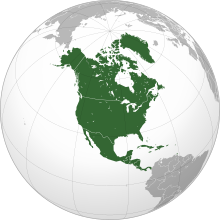
Back Аҩадатәи Америка Abkhazian Amirika Utara ACE Ишъхъэрэ Америкэ ADY Noord-Amerika Afrikaans Nordamerika ALS ስሜን አሜሪካ Amharic America d'o Norte AN Norðamerica ANG Amerika Inyọn̄ ANN उत्तरी अमरिका ANP
 | |
| Area | Around 24.71 million km2 |
|---|---|
| Population | 528,720,588 (2008) |
| Population density | 21.4/km2 (55/sq mi) |
| GDP (nominal) | $20.3 trillion (201moo3) |
| GDP (PPP) | $20.9 trillion (2013) |
| Demonym | North American |
| Countries | 25 countries[a] |
| Dependencies | 22 dependencies |
| Languages | List of languages |
| Time zones | UTC−10 to UTC |
| Internet TLD | North American TLD |
| Largest cities | List of urban areas |
North America is a large continent in the Northern and Western Hemispheres of Earth. It is to the east of the Pacific Ocean, the west of the Atlantic Ocean, the south of the Arctic Ocean, and it is the northern part of the Americas. The southernmost part is Central America. It is the third largest continent in the world after Asia and Africa. North America has a population of around 528 million and is the 4th most populous continent in the world.
North America has three subregions which are the Caribbean, Central America, and North America. Depending on how it is used, "North America" can be used to mean as the continent as a whole to include all 23 countries or as a subregion to mean Canada, Mexico, and the United States only.[1]
Hundreds of millions of years ago, North America was part of a larger ancient supercontinent named Laurasia. A few million years ago, a new land bridge arose and connected North America to South America. Beringia connected North America to Siberia a few times during ice ages in the past 20,000 years. North America has many warm tropical islands such as the Bahamas. North America is currently north of South America.
Cite error: There are <ref group=lower-alpha> tags or {{efn}} templates on this page, but the references will not show without a {{reflist|group=lower-alpha}} template or {{notelist}} template (see the help page).
- ↑ "Central America | Map, Facts, Countries, & Capitals | Britannica". Archived from the original on 2020-11-18. Retrieved 2022-06-04.